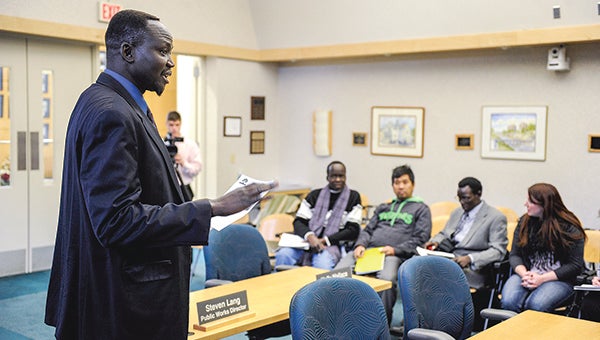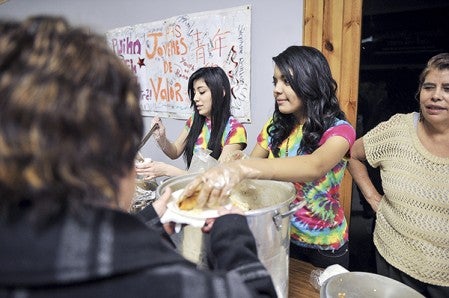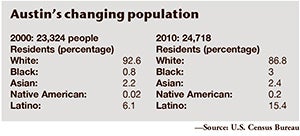A growing community

Chief Brown Bol opens a community brainstorming meeting Saturday for a South Sudanese community center. Eric Johnson/photodesk@austindailyherald.com
Chief Brown Bol surveys the room, waiting for residents to finish their conversations before he speaks.
A tall, almost imposing man with a big smile, Bol smiles and raises his arms, ready to start the meeting.
“Today, we are here to help my people,” he said.
Bol is one of a growing amount of community leaders from Austin’s communities of color, which over the years has become a vital part of the area. They represent new outlooks, new business opportunities, new ways to share cultures and ideas. It hasn’t always been easy, but Austin’s communities of color and changing demographics are bringing more to the community table every day and working to help Austin become a better place.
“You see a lot of new people in Austin each year, and it’s a good thing,” Austin Mayor Tom Stiehm said.
A big shift
Indeed, Austin has seen more than its fair share of new people in a short time. From 2000 to 2010, the city’s population grew by about 1,400 people, from 23,324 to 24,718, according to the U.S. Census Bureau. Yet Austin’s population shifted dramatically during that time.

Jazmyne Rodriquez serves up food with her cousin Maria Hernandez, left, at the Jovenes de Valor table at Taste of Nations in 2013 at the Oak Park Mall. The club is an Austin High School club. Herald file photo
Austin’s Hispanic residents more than doubled over that 10-year period, from about 6.1 percent to 15.4 percent of Austin’s population. The city’s black population also grew from less than 1 percent to 3 percent.
Austin isn’t unique in this regard. The city is one of about 17 so-called rural growth centers in Minnesota demographers have identified over the years. These communities all have food production plants or other factory work, and they’re drawing in more young families and families of color from urban areas to Greater Minnesota to find good work.
“It’s so nice to see so many people here,” said Miguel Garate, a longtime civic leader for the area’s Latino population.
Garate moved to the area in 1997 and quickly became an invaluable asset to the community. He was an interpreter across Mower County for anyone he could help and was a key leader to help bridge the cultural divide between Austin’s leaders and its new communities. He has also helped expand Riverland Community College’s international student program, which is still hailed as a model for other colleges and universities within the Minnesota State Colleges and Universities (MnSCU) system.
While Garate admits it hasn’t always been easy for the city and its Latino population to see eye-to-eye, he loves how many people of various backgrounds have come together here in Austin.
“Nowadays, I walk into the YMCA, and it’s so nice to see all the boys and girls playing with one another,” he said. “You didn’t used to see that, but the Y has been embraced by the Latinos, like many other places in the community. It’s great to see.”
As Austin’s communities of color have grown, so has its support systems and its activities. Many people band together each year to create the Taste of Nations, a scrumptious event where people eat their fill of food from more than 50 countries. The idea is simple: People come together easily over food.
It’s a great way to bond the community, and it helps build ties when things Austin’s new residents need help with arise.
Building bridges
The community has had to build plenty of ties and outlets to help new residents over the years, from the Welcome Center of Austin — which helps new residents of all kinds get situated in the community — to Austin Public Schools’ Success Coach program, which acts as a liaison for immigrant parents and students, and the local school system.
 Yet Austin’s communities of color may need more help.
Yet Austin’s communities of color may need more help.
Bol knows the area needs more help identifying the Sudanese community’s needs and addressing them. But he also knows how difficult it can be for the Sudanese, who are refugees from a war-torn area in Africa. The Sudanese are people who can’t return to their home, who must try to make their way in a foreign society.
“It is very much different for the Sudanese here,” Bol told a room of more than a dozen people in January, during a meeting he helped organize to get ideas for a Sudanese community center off the ground.
For Bol, a community center or other designated space would help Sudanese refugees educate one another, which would help with language barriers and any embarrassment Sudanese residents may have in asking for help. From English classes to parenting seminars, the community space would be a way to help Sudanese residents assimilate into U.S. society and become more involved in the community.
Bol wasn’t the first leader to help organize a community center campaign, however. Ojoye Akane, another longstanding community leader and now director of the African Asian Refugee Agency, remembered his and other leaders’ struggles to get a similar center built.
“You cannot build a center for just one community,” he said. “It has to be for all refugees.”
That’s why Akane and Bol have teamed up to work with the Karen, a fast-growing refugee population from Burma, to create a new refugee community center to help refugees from all backgrounds.
“When you address the needs of all refugees, you will find they all benefit,” Soe Myat, a Karen leader who works with Akane, said. “We all share the same issues, we all must work together.”
The center is gaining steam, slowly but surely. Stiehm and other city leaders have promised to work with Bol, Akane, Myat and other leaders of color to find them a space for the refugee center, once the proposed center is more fleshed out.
Recently, leaders have worked to meet with state legislators to see whether the center could benefit from state funding. Though talks are still in the preliminary stages, Bol said it’s encouraging to see so much action.
“It is a good thing for my people,” he said.
For Bol, a man who came to the U.S. many years ago, Austin is home for him and his family. Now, he’s excited to see Austin become home for many people as the city continues to grow.
“We want to become part of the community, too,” he said.

